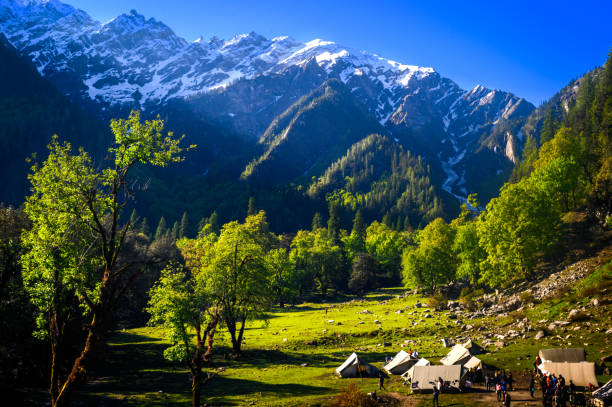Himachal Pradesh, nestled in the northern part of India, is a paradise for nature enthusiasts and wildlife lovers. This picturesque state boasts a variety of wildlife sanctuaries, each offering unique ecosystems and a rich diversity of flora and fauna. In this blog, we explore some of the prominent wildlife sanctuaries in Himachal Pradesh, showcasing their natural beauty and the incredible wildlife they harbor.
Renuka Wildlife Sanctuary
Located in the vicinity of Renuka Lake in Sirmaur district, Renuka Wildlife Sanctuary is a haven for nature lovers. Spread over 402 hectares with an additional 300 hectares of buffer zone, the sanctuary is known for its dense forests, freshwater springs, and rich biodiversity. Dominated by mixed deciduous forests, the sanctuary features trees like Sal, Shisham, Khair, and various climbers.
Renuka Wildlife Sanctuary is home to an impressive array of wildlife, including leopards, sambars, spotted deer, barking deer, jackals, black bears, and porcupines. Birdwatchers can delight in spotting species such as the red jungle fowl, khaleej pheasant, blue jay, black partridge, drongos, scarlet minivet, and common coots. Additionally, the sanctuary houses a mini zoo that shelters rescued and abandoned animals.
Churdhar Sanctuary
Spanning 56.16 square kilometers along the Churdhar range in Sirmaur, Churdhar Sanctuary is characterized by its western mixed coniferous forests, including large plantations of Kharu oaks, cedar, blue pine, and spruce. This sanctuary’s rich green cover makes it a picturesque destination for trekkers and nature enthusiasts.
Churdhar Sanctuary is home to a variety of wildlife, including leopards, Himalayan black bears, barking deer, ghorals, and musk deer. Bird species such as the monal pheasant, khaleej pheasant, and red jungle fowl can also be spotted here. The sanctuary offers excellent trekking trails that allow visitors to explore its natural beauty.
Kalatop-Khajjiar Sanctuary
Located in Chamba district, Kalatop-Khajjiar Sanctuary covers an area of 17.17 square kilometers and is renowned for its dense forests of blue pine, deodar, oaks, and flowering rhododendrons. This sanctuary is a rich habitat for Western Himalayan flora and fauna, making it a must-visit for wildlife enthusiasts.
The sanctuary is home to leopards, black bears, barking deer, goral, and serow. Bird species such as the cheer pheasant and khaleej pheasant are commonly sighted. With well-laid-out trekking trails at both Kalatop and Khajjiar, visitors can experience the wildlife and scenic beauty up close.
Daranghati Sanctuary
Once the game reserve of the Bushehar rulers, Daranghati Wildlife Sanctuary spans 171 square kilometers and offers a diverse array of habitats. The sanctuary is divided into two parts, accessible from Rampur and Sarahan. The region is known for its historical significance, with the legendary Old Hindustan-Tibet Road passing through it.
Daranghati Sanctuary is home to a variety of mammals, including the Himalayan brown bear, Himalayan black bear, Himalayan musk deer, serow, Himalayan weasel, and blue sheep. Bird species such as the koklass pheasant, cheer pheasant, and khaleej pheasant are also abundant. The sanctuary’s high mountains and scenic trails make it a popular destination for trekking and wildlife observation.
Kanwar Sanctuary
Situated in the Parvati Valley of Kullu district, Kanwar Wildlife Sanctuary covers 107 square kilometers and features diverse landscapes ranging from 1800 to over 4800 meters in altitude. The sanctuary’s forests include oak, deodar, mixed conifers, blue pine, spruce, and fir, transitioning to alpine pastures at higher altitudes.
Kanwar Sanctuary is known for its healthy population of Himalayan thar. Other wildlife includes black bears, brown bears, musk deer, barking deer, goral, ibex, leopards, and snow leopards. Bird species such as the khaleej, monal, cheer, and Western tragopan pheasants can also be spotted. The sanctuary’s proximity to Kasol and Manikaran makes it easily accessible for visitors.
Rupi Bhawa Sanctuary
Nestled in the shadow of the Shrikhand mountain range, Rupi-Bhawa Wildlife Sanctuary spans 503 square kilometers across Lower Kinnaur. The sanctuary’s elevation ranges from 2000 to 6000 meters, with extensive alpine pastures and numerous treks connecting it to the Great Himalayan National Park and Pin Valley National Park.
Rupi-Bhawa Sanctuary is home to snow leopards, brown bears, black bears, musk deer, serow, thar, Himalayan weasels, and blue sheep. Bird species such as the Western tragopan, monal, koklass pheasant, cheer pheasant, khaleej pheasant, chukar partridge, and black francolin are also found here. The sanctuary’s diverse habitats and remote location make it a unique destination for wildlife enthusiasts.
Rakchham Chitkul Sanctuary
Named after the villages of Rakchham and Chitkul in the picturesque Sangla Valley, Rakchham Chitkul Wildlife Sanctuary covers 304 square kilometers. The sanctuary is known for its stunning landscapes and rich biodiversity, making it one of the most beautiful destinations in Himachal Pradesh.
The sanctuary is home to snow leopards, brown bears, black bears, musk deer, Himalayan thar, Himalayan weasels, and blue sheep. Bird species such as the Western tragopan, monal, koklass pheasant, cheer pheasant, khaleej pheasant, chukar partridge, and black francolin are also prominent. The sanctuary’s high passes and scenic trails offer adventurous trekking opportunities.
Majathal Sanctuary
Located in the hilly terrains of Solan and parts of Shimla districts, Majathal Sanctuary covers 31 square kilometers and is known for its typical low-lying Western Himalayan flora and fauna. The sanctuary’s altitude ranges from 900 to 2000 meters, making it an excellent habitat for the cheer pheasant.
Majathal Sanctuary is home to leopards, ghorals, and barking deer. Bird species such as the cheer pheasant, khaleej pheasant, red jungle fowl, peafowl, and black partridge are commonly sighted. The sanctuary’s proximity to Shimla, Solan, and Bilaspur makes it easily accessible for visitors.
Chail Wildlife Sanctuary
Spread over 16 square kilometers around the hill station of Chail, Chail Wildlife Sanctuary is known for its rich biodiversity. The sanctuary’s thick deodar and oak forests, along with small grasslands, provide a habitat for various animal and bird species.
Wildlife in Chail Sanctuary includes sambars, gorals, cheer pheasants, barking deer, wild boar, hares, and khaleej pheasants. Bird species such as the chukor, peafowl, red jungle fowl, woodpecker, and black partridge are also found here. The sanctuary’s Cheer Pheasant Breeding Centre offers visitors a closer look at this beautiful bird.
Manali Wildlife Sanctuary
On the outskirts of the popular resort town of Manali, the Manali Wildlife Sanctuary spans 29 square kilometers and is a favorite among wildlife enthusiasts. The sanctuary’s dense deodar and maple forests provide a rich habitat for various species.
The sanctuary is home to rare wildlife such as the musk deer, black bear, leopard, and barking deer. Bird species like the monal pheasant and khaleej pheasant are also present. The sanctuary’s scenic trails and proximity to Manali make it an ideal destination for nature lovers.
Kibber Wildlife Sanctuary
Kibber Wildlife Sanctuary, the largest in Himachal Pradesh, covers 2220 square kilometers and ranges in altitude from 3600 to 6700 meters. As the only cold desert wildlife sanctuary in India, Kibber offers a unique environment for rare flora and fauna.
The sanctuary is home to snow leopards, ibex, blue sheep, Tibetan wolves, red foxes, and woolly hares. Bird species such as the Himalayan snowcock, golden eagle, Himalayan chough, Himalayan finches, and snow pigeon can also be spotted. The upper reaches of Kibber Sanctuary provide excellent opportunities for wildlife photography, especially for capturing the elusive snow leopard.
Conclusion
Himachal Pradesh’s wildlife sanctuaries offer a glimpse into the rich biodiversity of the Western Himalayas. Each sanctuary has its unique charm and provides a habitat for a diverse range of flora and fauna. Whether you are a nature enthusiast, a bird watcher, or an adventure seeker, these sanctuaries offer unforgettable experiences and a chance to connect with nature in its purest form. From the dense forests of Renuka to the high-altitude deserts of Kibber, Himachal Pradesh’s wildlife sanctuaries are truly a treasure trove of natural beauty and wildlife.



